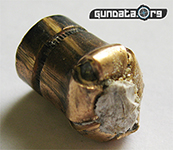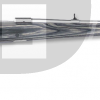Hollow Point Bullet Failure Up Close
Article Posted: April 6, 2012
Hollow Point Bullets are bullets with a hollow pit or cavity on the upper section of the bullet (not the casing), that mushroom or expand upon impact to increase surface area and ensure that the target absorbs 100% of the energy by decreasing the chance of over-penetration (when a bullet passes through a target). A mushroomed hollow point bullet increases both temporary and permanent cavitation and by proxy boosts the likelihood that the projectile will incapacitate said target.
So what is a hollow point failure?
So what is a hollow point failure? It is when a hollow point fails to expand. How does a hollow point expand to begin with. Most hollow point bullets have a cavity filled with lead a fairly soft and malleable material, and they are covered and backed by a more sturdy metal like copper. The force of impact is such that the lead being malleable attempts to find the path of least resistence, in this case outward in a circular direction. Even covered with a copper jacket (outside lining) the lead produces enough outward force to properly expand the copper as well.
OK..but again how do they fail? When a foreign material like clothing packs and condenses the hollow point with enough material, the foreign material not the lead receives the pressure of impact. That material then directs the energy backwards into the tail of the bullet and not outward, and the end result is failed or uneven hollow point expansion.
Combating Hollow Point Failures
Bullet manufacturers have spent millions of dollars in developementation, and experamentation, submitted patents, and even filed lawsuits in attempt to tame this beast. As of yet there is no bullet on the market that will not fail at some point.
These are some of the actions taken, or types of adjustments being made to help improve hollow point expansion rates.
Serrations:When we say serrations to the ridged and thined lines on the copper jacked. These lines look and ack similar to the dotted lines on coupons and bills. The lead filler upon compression push outward on the copper jacket "tearing" it along the "dotted line". These tears are meant to be even, and because they are even they increase the likeyhood that the hollow point will expand evenly.
Fillers:Companies like Hornady have come out with some great synthetic fillers that increase the bullets a aerodynamics, but more importantly prevent foreign material from entering the cavity. These materials seem to be of a rubber material that is softer and more maleable than the lead, and creates a 3rd layer if you will, of bullet tip material. Inner layer..ruber, next layer lead, last layer copper. Hornady also combines the previous technology of serrations in their critical defense bullets.
Shape:The tips initial shape will invariably effect the way the hollow point expands. Bullets with higher velocities tend to have smaller openings because their fps and energy are enough to properly create the mushrooming effect desired. Slower rounds like pistol rounds tend to require larger holes in because there is less energy to be funneled outward.
Depth: In regards to the depth or height of the bullet or cavity, you will see different variations even in the same caliber. These small changes have been made to improve performance.
Coating: The most popular coating is copper, it is a stronger material than the lead core often has serration marks as well. Other material may come out in the future by for now coatings/ jackets are mostly copper.
Link to this Article: http://gundata.org/blog/post/hollow-point-bullet-failure/
Related Articles
Please like, share, favorite, bookmark, and comment. Thank You.
Main Menu
Original Articles
- New 25+1 Capacity Shotgun!
- Hudson H9 American Made 9mm
- How To Build A Mud Hut
- Pistol Looks Like Cell Phone
- 45 ACP vs 9mm Luger
- Best 9mm Carbines
- Mall Ninja Xtreme Zombie Carbine!
- 5 Alternative Range Bags for Pistols
- Best 45 ACP Carbines
- 5 Dirt Cheap Guns $170 to $260
- Muslim Free Shooting Range?
- How To Clean A Rifle
- 3 Good 300 AAC Blackout Reviews
- Top 5 Guns for Women
- How to Really Shoot A Pistol
- Worlds Best 9mm Handgun
- 5 Great Gun Safes (Options)
- 9mm vs 40 S&W Summary + Ballistics
- Red Oak, White, or Chestnut for Deer Herd?
- Bullets for Barter Post Collapse
- Funny Pro Gun Sayings
- 5 Strange Handguns You Don't Need
- 3 Great .22LR / 410 Survival Rifles
- American Rifles | The Original ARs
- 600 Round Glock Magazine
- 10mm vs 40 Summary and Ballistics
- How Important is "Shot Placement"?
- 10 Item First Aid Kit Checklist
- 10 Gun Lights for Home Defense
- How to Make a Stove Hobo Style!
- Most Basic Survival Food List Ever
- Best Handguns for Women
- Make Homemade Mosquito Trap
- Lets make a Sawed-Off Shotgun!
- Man Brings Knife to Gun Fight (Funny)
- Gun Store Etiquette (Proper vs Improper)
- 10 Simple Home Security Tips
- SIG-Sauer vs Glock
- Legal Length of Shotguns and Rifles
- 9mm Pocket Pistols
- Glock 17/19/26 Operating Procedures
- 10 Conceal Carry Tips (Funny)
- Understanding the 2nd Amendment
- Choose Your Own Crime Stats
- After You Dial 911 : Dont Be A Victim
- Does Gun Control Work?
- Best Shotgun Ammo for Self Defense
- Best Calibers for Self Defense
- FBI Handgun Ballistics
- 38 Special vs 380 ACP
- Top 5 Home Defense Handguns
- 5 Best Home Defense Shotguns
- How to Sight in a Scope - Step by Step Guide
- .380 ACPs Stopping Power (Funny)
- AK-47 vs AR-15 History and Facts
- A Bug Out Bag Checklist for 2015
- 30-06 vs. 270 Win
- Gun Stores
Ballistics Tools & Data
- Ballistic Trajectory Calculator
- Ballistic Coefficient Calculator
- 9mm Ballistics Chart
- 308 Ballistics Chart
- 30-06 Ballistics Chart
- .270 Win Ballistics Chart
- 30-30 Ballistics Chart
- 7.62x39mm Ballistics Chart
- 7mm Rem Magnum Ballistics Chart
- 17 HMR Ballistics Chart
- 223 Ballistics Chart
- .243 Ballistics Chart
- 22-250 Ballistics Chart
- Convert FPS to MPH












